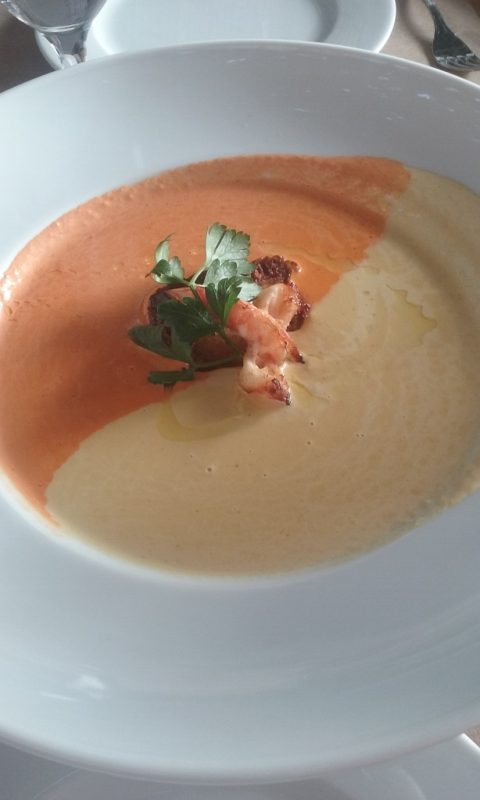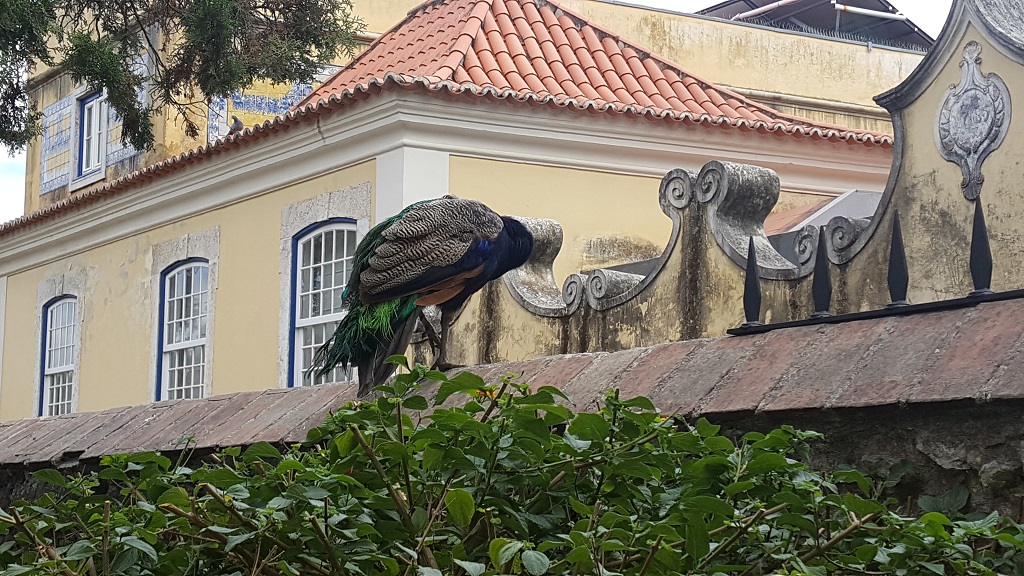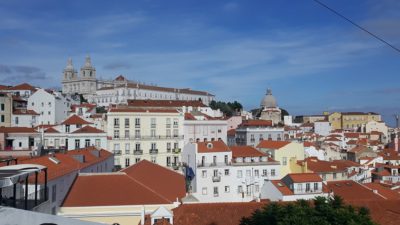
Classic Portugal
Oct. 11: It’s chilly and raining outside, but it matters not. We are enjoying some late night tea in our room at the Lisbon Pousada. We started the day with breakfast at the pousada before embarking on a day of exploration of the Alfama district. From our research, both Dan and I were most intrigued by this part of Lisbon. It’s the only part of the city that was not destroyed by the earthquake in 1755.
On November 1st, 1755, a catastrophic earthquake hit Portugal. Since it was All Saint’s Day, many of the buildings had candles lit in them for ceremonies. So whatever the earthquake didn’t destroy, unfortunately got burnt down, as the candles shook loose and set the buildings on fire. On a corollary note, this earthquake was the beginning of the fall of Portugal’s day as an empire. They have never recovered from it and, for Western European standards, it is a relatively poor country. The year 1755 is an omnipresent reference in any discussions about Portuguese history. The question is whether some event happened before or after the earthquake.
The Alfama was luckily spared much of the drama. Perhaps it was because it is slightly higher in elevation or maybe it was pure luck. The streets are narrow and windy, not all grid-like or easy to navigate. Once you get in there, you are literally in a maze. The Alfama still drips with old town charm. The vision that lives in your mind of what Lisbon was like is a very real thing in the Alfama. Worn tiled buildings are decorated with hanging laundry. Small family run cafes grill up sardines and one can hear the melodic sounds of fado music drifting through the windy cobbled streets. It truly is like stepping back in time.
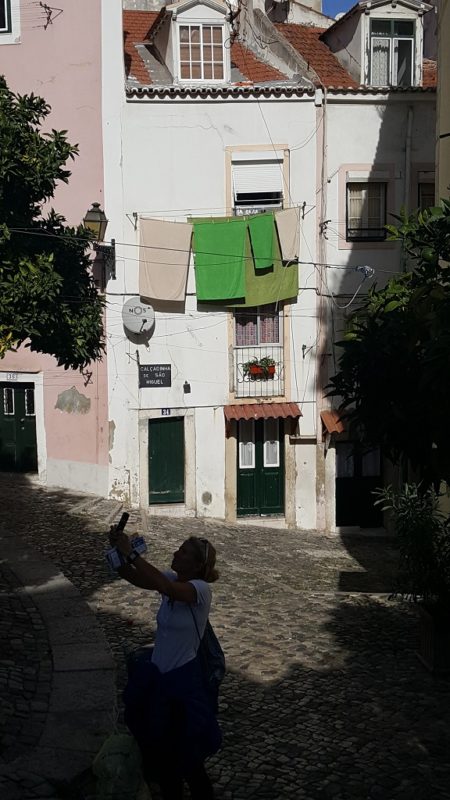
This Depicts the Vibe of the Alfama
The Sé Cathedral immediately drew us in as we started our exploration of the Alfama. With its massive walls and two stout clock towers it almost more like a fortress than a religious center. It was originally constructed by 12th Century Crusaders who built in on a mosque that formerly occupied the site. Although certain parts of the sanctuary were highly decorated, the Gothic interior was actually dark and less decorated than a lot of other European churches. For instance, above the apse was painted with what looked like Renaissance artwork. It has seen many alterations over the years, including the repairs after the earthquake of 1755 when the roof fell in on a full house celebrating All Saints Day. Our understanding was that the beautiful Romanesque rose window was actually reconstructed from the fragments left by the earthquake.
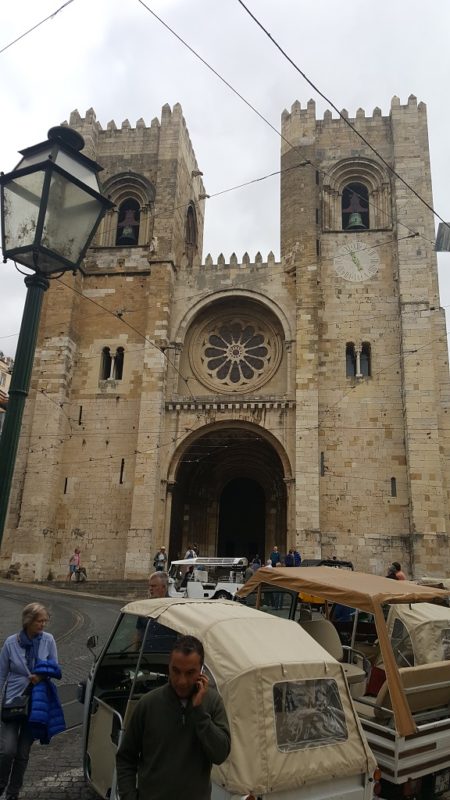
The Sé
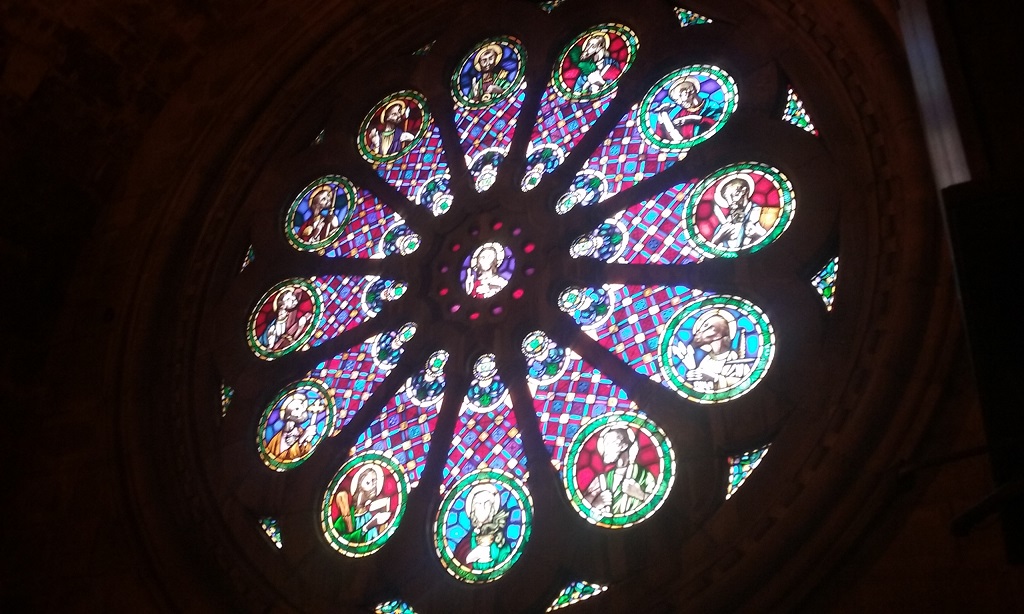
The Romanesque Rose Window
For us, the most interesting part of the Sé was the gothic cloister. We purposefully paced around the cloister the way the monks had done many years ago getting into the vibe. The center of the cloister in recent years has been excavated to reveal the many layers of history that came before. There were Roman streets and stores on the bottom, which dates back to over 2,000 years ago. Then the Muslims built on top of the Roman ruins. Remnants of their communal building with red paint and their dump were visible. The cloister was added to the Sé in the late 1200’s and they used the stone from the Muslim occupation as fill for the construction.
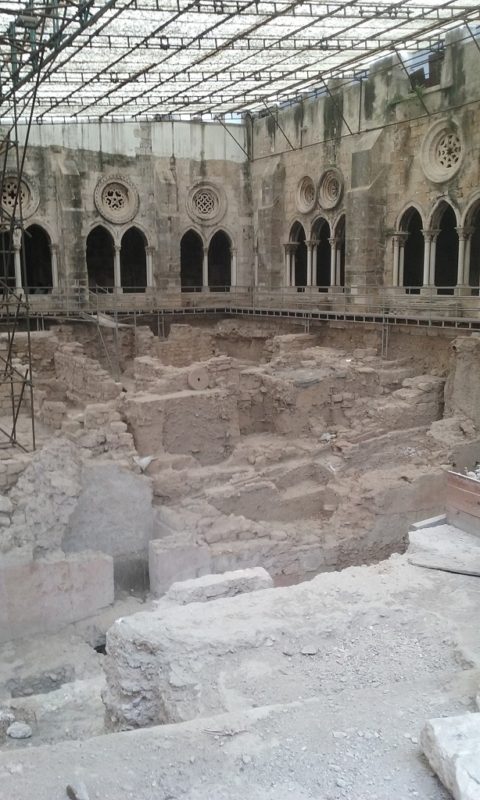
You Are Looking at 2000-plus Years of History Here
For people today these ruins are interesting and amazing historical relics to be preserved as much as possible. But centuries ago, each successive culture thought nothing of tearing down old buildings to be used as fill and foundations for their new construction.
Our next must do in the Alfama was the Castelo de São Jorge. So we headed up the hill where it is located, but we took our time getting there, as we wanted to soak up the Alfama. On the way we even stopped at a gift shop that looked more traditional and less touristy and I picked up some tile and cork made by local artists.
The miradoura by Igreja Sao Luzia was worth a gander. It is surrounded by eye catching bougainvillea that was in full bloom, bursting with different shades of pink. The walls and benches were covered with blue tile artwork that looked very worn. We were wondering if they were being affected by time or by tourists trying to peel them off. And as we looked down toward the river, orange clay rooftops dominated the landscape and screamed “Portugal.”
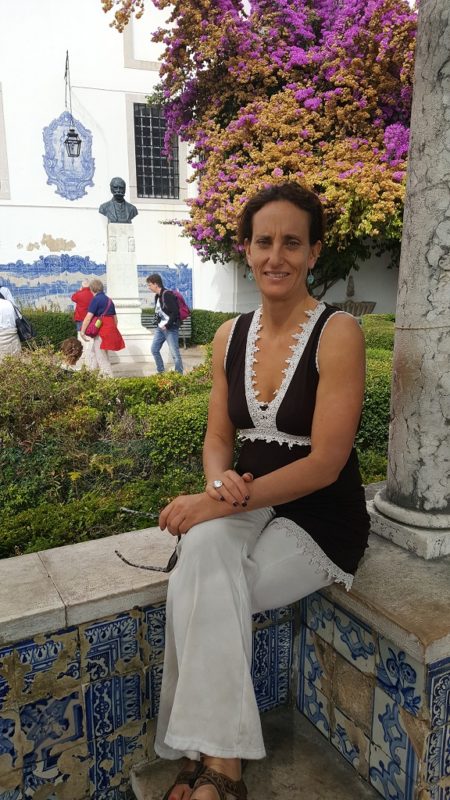
Checking Out the Miradoura …
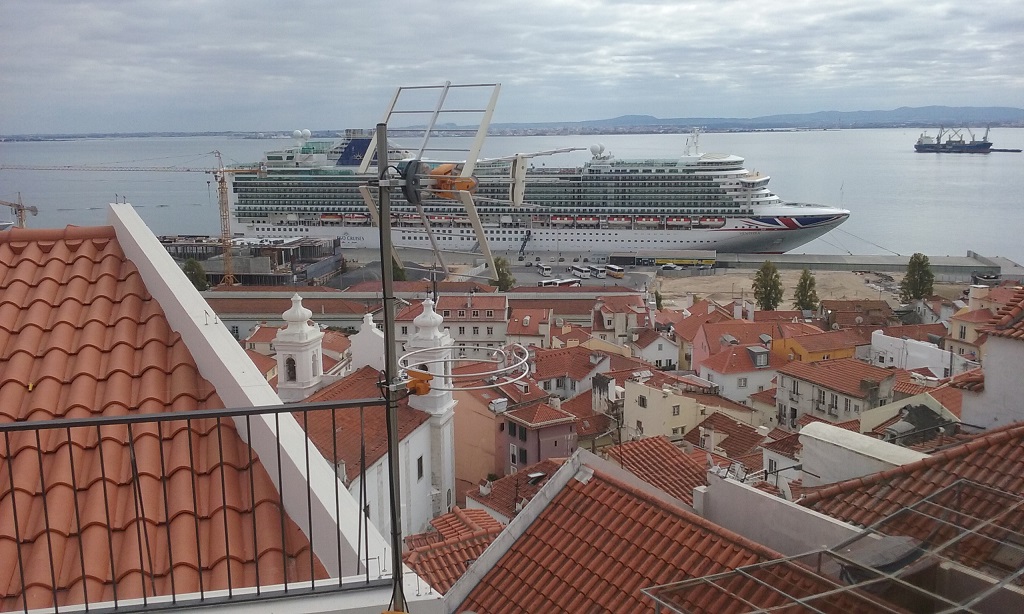
… Which Looks out to the Tagus
Like so many other places we’ve walked, street musicians were gracing the public with their melodic tunes. There is plenty of street music in Lisbon, more than a lot of other places I’ve been. And there is no common thread to the types of music you hear. It can range from folk guitar, to handmade drums, to African music, to Fado, to Pearl Jam and you name it. But it’s always present when we walk by praças and miradouros and esplanades.
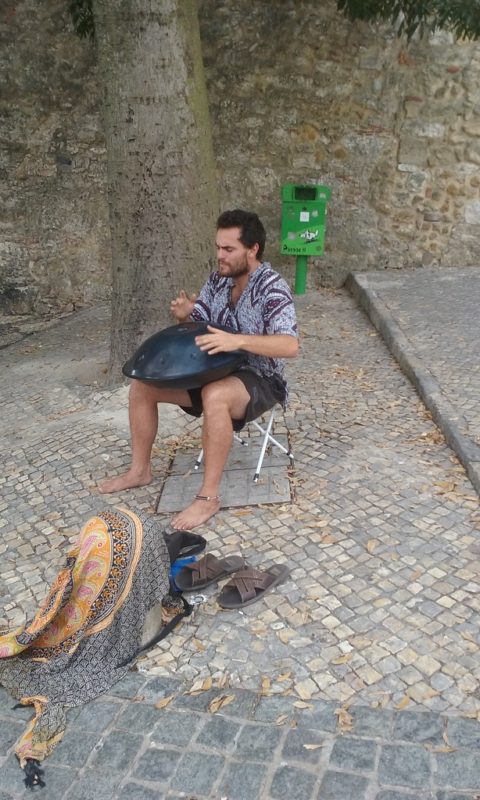
He Was Playing a Unique Type of Drum
Our last stop before reaching the castle was a store called Miss Can where we checked out the canned fish. We were warmly greeted by Tiago, the young entrepreneur who had brought his grandfather’s recipes back to life. His grandfather died before he was born. His parents did not continue canning fish, but they were able to pass on the recipes to him. Three years ago, he and his twin sister and their one other business partner launched Miss Can.
His grandfather’s tricks included steaming the fish before canning to draw away excess fat. He only used fresh fish, never frozen. And he ages the fish in the can for six months at a minimum so it can fully cure. Tiago was extremely proud of where the business had gone so far, and he has big aspirations for where it will go. He mentioned that before the store opened seven months ago, they sold the fish out of a tuk tuk at the castle we were headed to. It is interesting, but some of the same sardine canning “discoveries” were touted as having been made in the early 1900’s when Dan visited the Monterey Bay Aquarium in California.
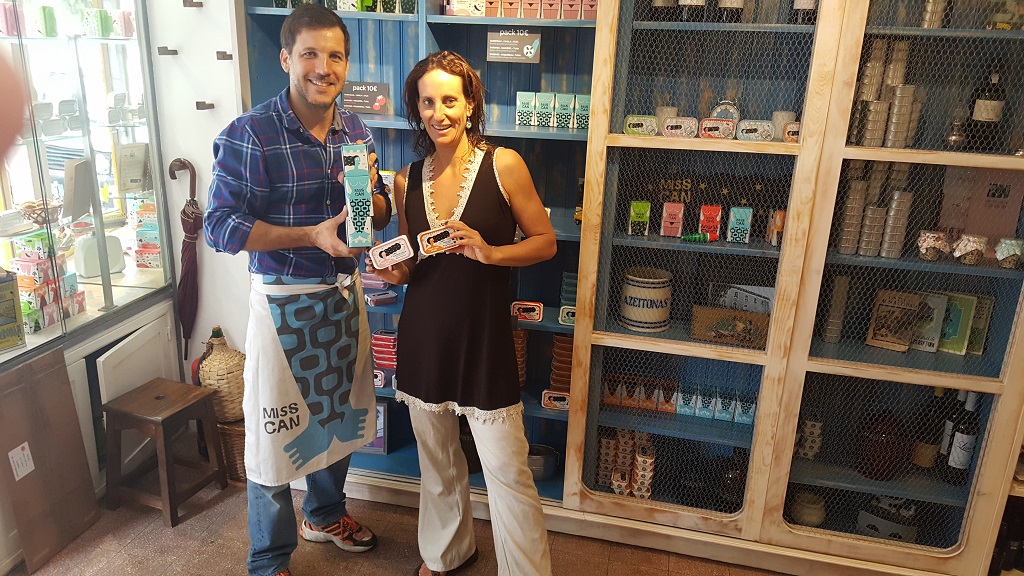
Tiago Is the Entrepreneur Behind Miss Can
Having fostered a nice connection with Tiago, of course we wanted to patronize his business. We picked up a few types of fish and flavors to bring back to the States and snack on here as well. Tuna, mackerel, sardines and cod are the biggies of the region. Flavors included spiced olive oil and poviera sauce, which comes from a village up in northern Portugal.
Soon enough we were at the castle, the pinnacle of the Alfama, along with many other tourists. However there is room to spread out, and we enjoyed the majestic views that its hilltop location offers. When we were exploring the rest of Lisbon, we were often looking up at its dominating perch. Now we could take advantage of that perch.
Like the cloister, the castle has multiple levels of history. The Romans first built fortifications here in approximately 200 BC. Later when the Moors took over, they built significant fortifications on top of the Roman structure. Around 1150, the Christians took over and occupied and continued to use it as protection, to defend the city of Lisbon. We climbed the steps and walked atop the walls to the lookout points in the towers. In the distance facing west, were the open waters of the Atlantic where the Portuguese navigators sailed to establish the Portuguese empire in the days of the 1400 and 1500’s.
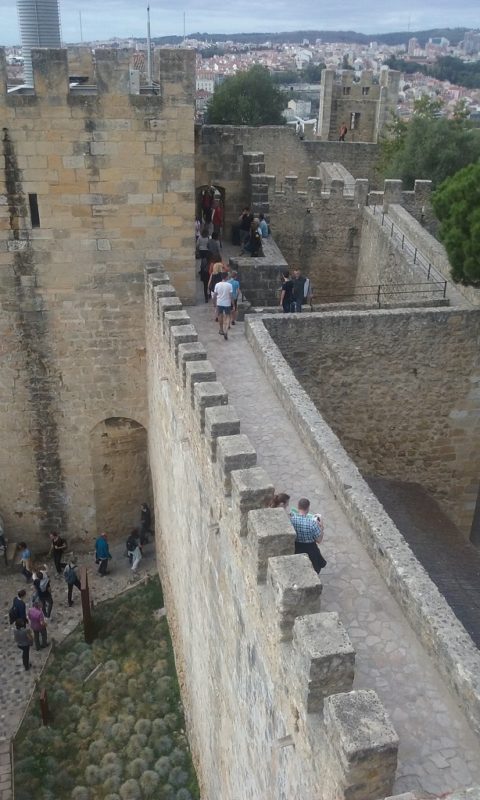
Castles Are Wonderful to Climb Around and Explore
When we came down and walked around the Romantic Gardens and the courtyard surrounding the forts, we noticed Miss Can’s tuk tuk. There were also tuk tuks selling wine. People sipping wine and sitting on the ancient rocks overlooking Lisbon were plentiful. It was warm and sunny so we sat at a rock table and blogged a bit while we enjoyed a most delicious can of spicy sardines, from Miss Can.
It being apparent that the Alfama is true gem, we were in no rush to leave. We stayed fully engaged in the old world experience by getting a bit lost in the labyrinth of streets, many of which were wide enough to fit a car, and not much more. The main way to know you are on the right path here is by observing if you are going up or down. Eventually you’ll get to where you are going if you follow this rule of thumb.
Lisbon in general, but certainly the Alfama is a very colorful neighborhood on different levels. The homes are painted colorfully. The tiles on the façades of the buildings are colorful and rarely is a design ever repeated between the buildings. Although the artistic style of the tile follows a common theme, they are each their own unique kaleidoscope of design and color. And there are murals here and there on the backsides of the buildings. All sorts of different art styles were represented, some more amateur or developed than others.
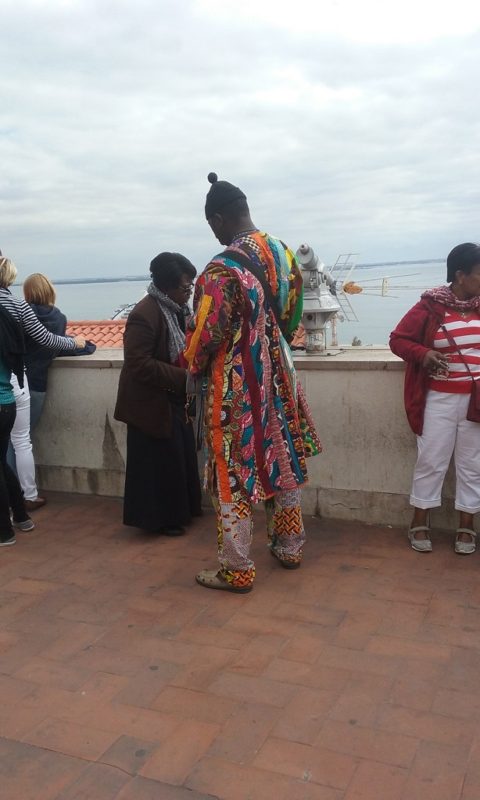
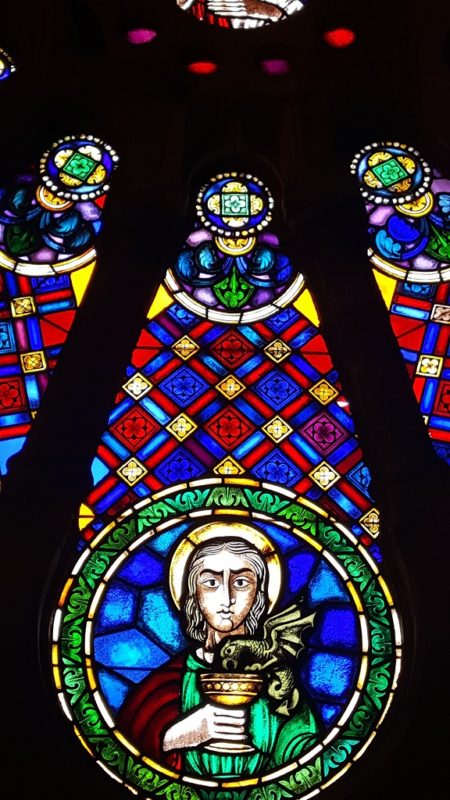
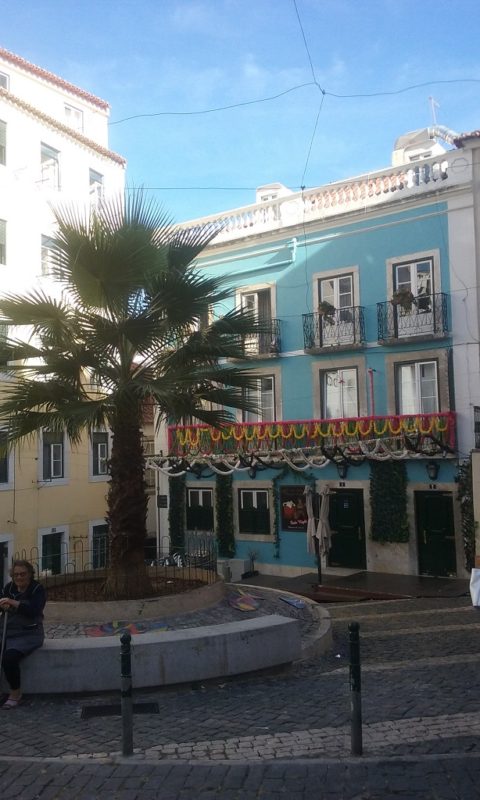
The Alfama Is a Colorful Place
A lovely sidewalk café underneath a sprawling grape arbor served as a nice place to get a midday snack. The food was simple and fresh and we opted for salads with codfish in it. Codfish is the ubiquitous ingredient that can take on so many forms and flavors in Portuguese cooking. The Portuguese call it bacalhau, although this refers specifically to it being dried and salted.
It seemed like every time we looked up, a clamoring group of 40 tourists would come pulsing by. We wondered how many of these groups were from the humongous cruise ships we saw docked. Some of the cruise ships we saw must have had a capacity for at least a couple thousand rooms. In their afternoon exploration of Lisbon, they were taken to the Alfama in droves. While Dan and I cringe at this style of tourism, we were curious as to how the locals think about it. When the tourist pods come through, it obliterates the normal activity of the streets. Yet, there are probably different ways to react to it.
Following our own rule of heading downward, we emerged from a narrow street into a square right in front of the Fado Museum. It was very digestible sized museum. It featured a lot of artwork that was about Fado artists, or scenes of Portuguese life that had strong relationships to Fado music. An example is a three panel painting which shows sailors leaving home and eventually pulling back into port to be reunited with their family. In the meantime out at sea, they sailors strummed their instruments, invoking the melancholic feelings so strongly associated with fado music.
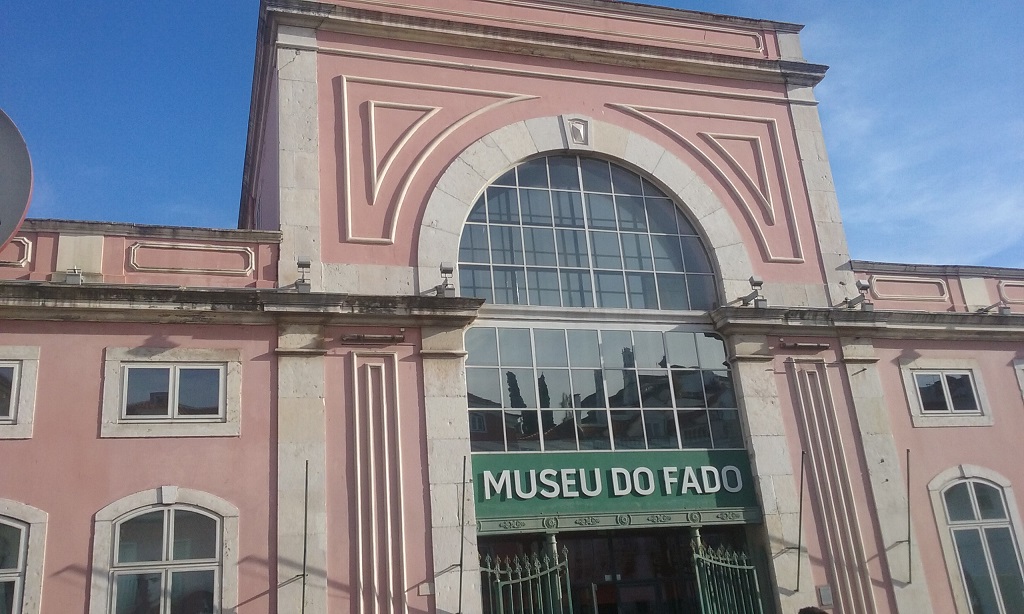
The Alfama Is Where Fado Was Born
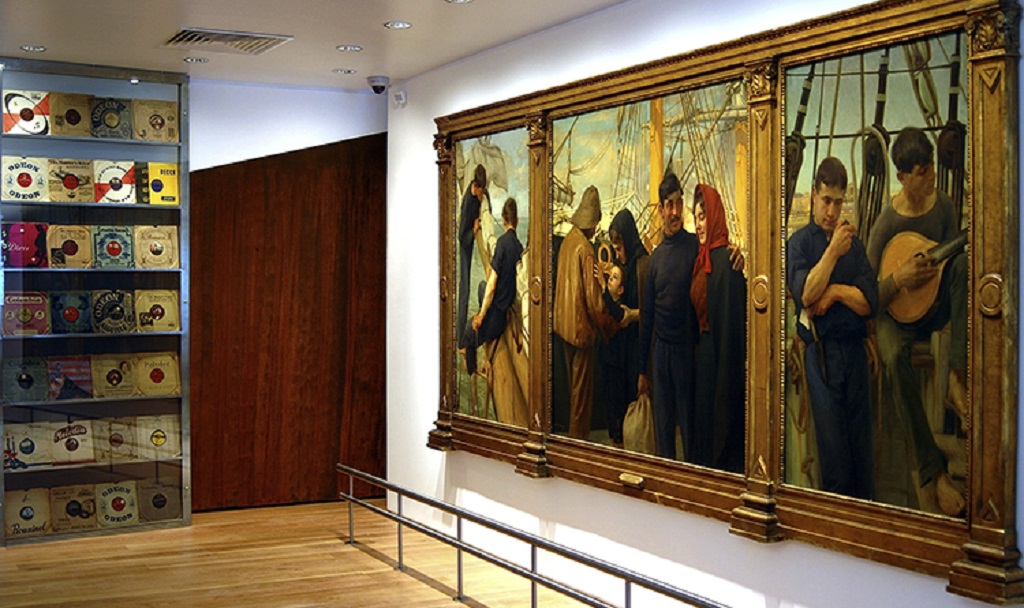
The Painting That Tells the “Story” of the Source of Fado
Fado music first began in the mid 1800’s and at the time, it was very underground, although it began to grow. The government passed regulations on what it could encompass and where it could be played. Although there’s a downside to this, the upside was that it spread more widely amongst the common citizens and fado became more nationally recognized, as opposed to being something that mostly took place in the Alfama. Unfortunately it became somewhat discredited in the mid-1900’s when the dictatorship took it over as a propaganda vehicle. However, it was reborn when Amelia Rodriguez reenergized it in the 1940’s.
Exiting the museum and heading downward, we finally wound our way back to level ground and the grid-like streets built post 1755. We immediately sensed when we left this old world gem and entered the hurly burly of modern Lisbon. It was almost like when Alice in Wonderland navigates the rabbit holes and eventually comes out the chute and voila, it was all just a dream.
Back at the pousada I visited the gym and went for a swim and sauna. The other guests in the sauna struck up a conversation. When they found out I was American, they immediately inquired about the upcoming presidential election. The Irish woman stated that the American political scene is some of the most humorous she has ever seen. The German man stated that Trump as president would be a catastrophe on the scale of the earthquake of 1755.
After exercising and decompressing a bit, we had dinner reservations at Belcanto. The chef, Jose Avillez studied under Alain Ducasse and his restaurant is the only Michelin** restaurant in Portugal. It was located in the nearby Chiado district, so we walked. When we arrived, we actually needed to knock to get in. We were greeted with warmth and taken to our seat. It looked very promising.
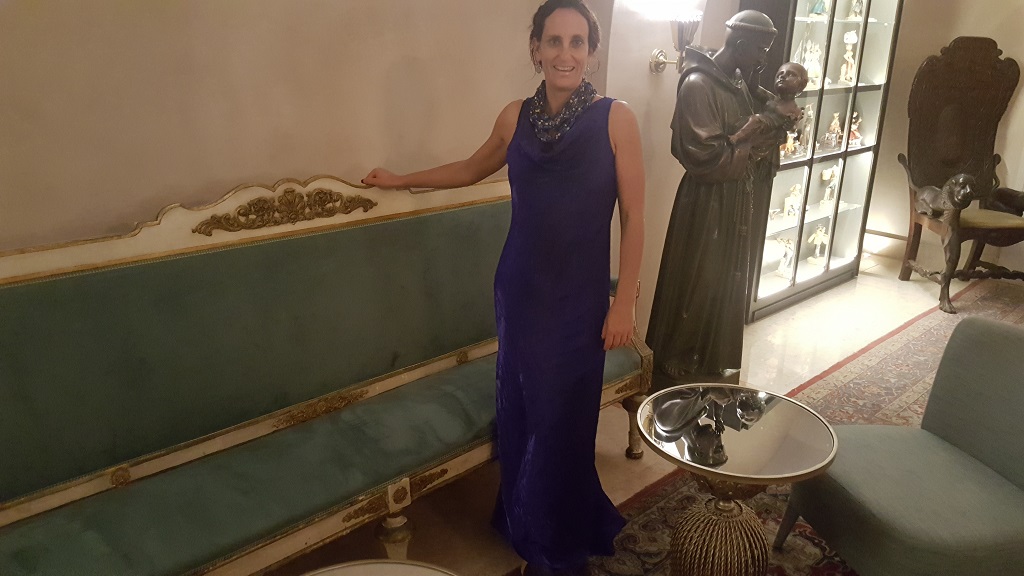
We Were Eagerly Heading to Belcanto
There were two tasting menus, one called Lisbon and one called Discovery. Lisbon had some traditional dishes and Discovery was based on the concept of recipes that incorporated the cuisines from the countries Portugal came into contact with during the Age of Discovery. They wouldn’t tell us what was on the menu. When we inquired, the waiter would only answered coyly “do you like surprises?”
It happens that we do like surprises and were willing to take a chance. By the end of the meal, Dan and I both agreed this was a superb meal and the service was excellent, but we failed to see any correlation between the dishes and the Age of Discovery. When Dan overheard a different waiter coyly asking another table “do you like surprises?” we realized we were just woven intof the nightly script.
As part of the “surprises” theme our initial courses were surprises on multiple levels. Our server assured us that they would provide us with explosive surprises when we ate them. Jose makes shells with coconut butter and then fills them with various taste treats. The first round had explosions with a carrot purée, a garlic preparation, and a lemon custard. It is a little bit of a cutesy gimmick, but it actually works. Our mouths were flooded with delicious flavors. The next round of explosives featured a serving of tasty “rocks” with the server warning us to be careful which rocks we bit into.
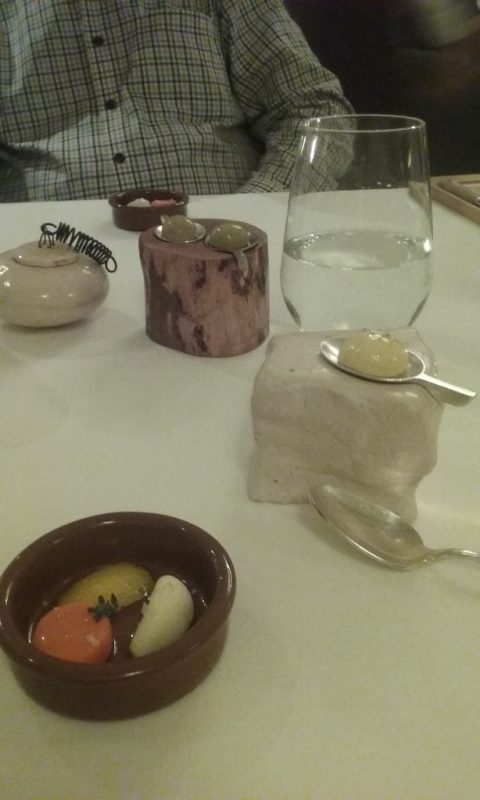
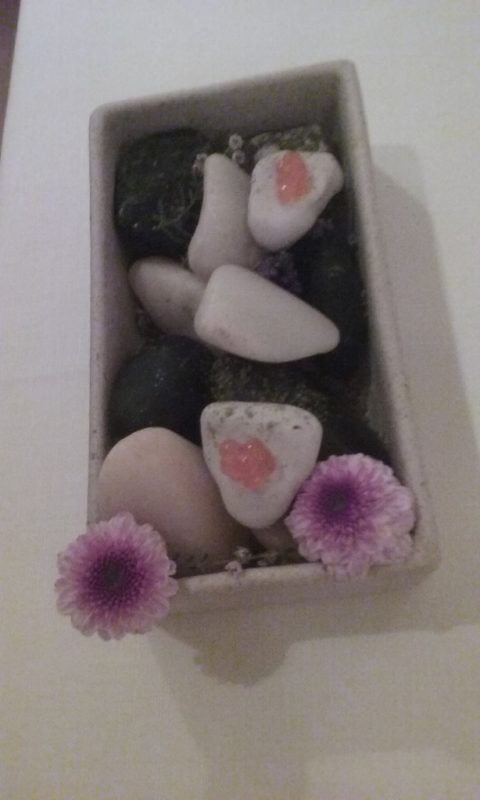
Exploding Garlic and Edible Rocks Were Part of the Discovery Process
Eating barnacle stew was a first for Dan and me. It was quite the delicacy. It was a savory soup broth full of percebes (barnacles) which were sweet and reminiscent of clams. The seaweed and sea beans added complexity and the caviar gave a pop of briny freshness. A heavenly bowl that is truly sweet and oceanic.
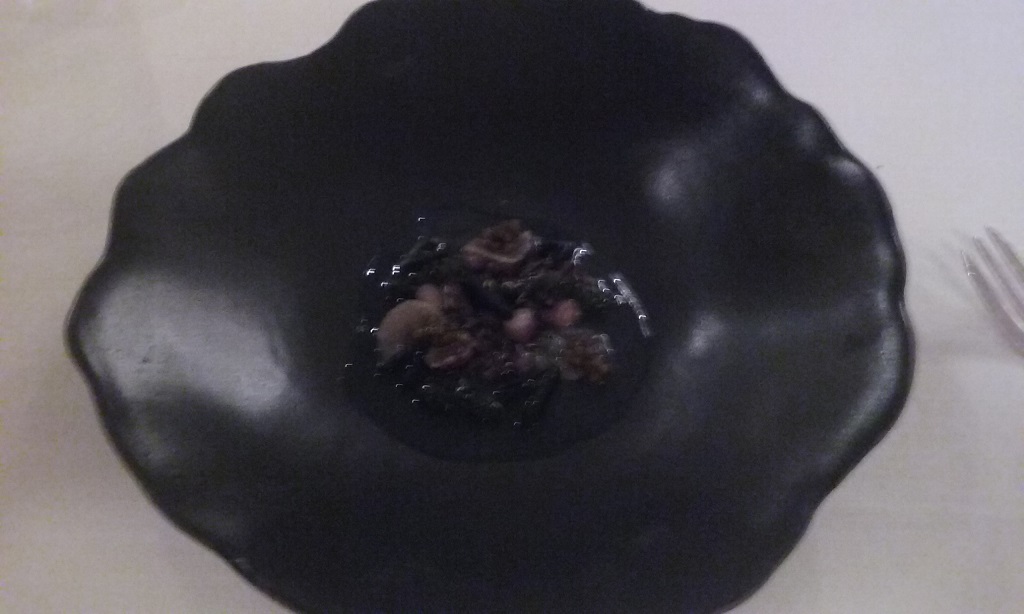
Barnacle Stew Was an Oceanic Experience
We both really loved the sea bass that was poached to perfection. It was nestled on top of king crab meat and then topped with more king crab meat, sunroots, and peas. This dish was delightfully delicate while still maintaining a depth of flavors.
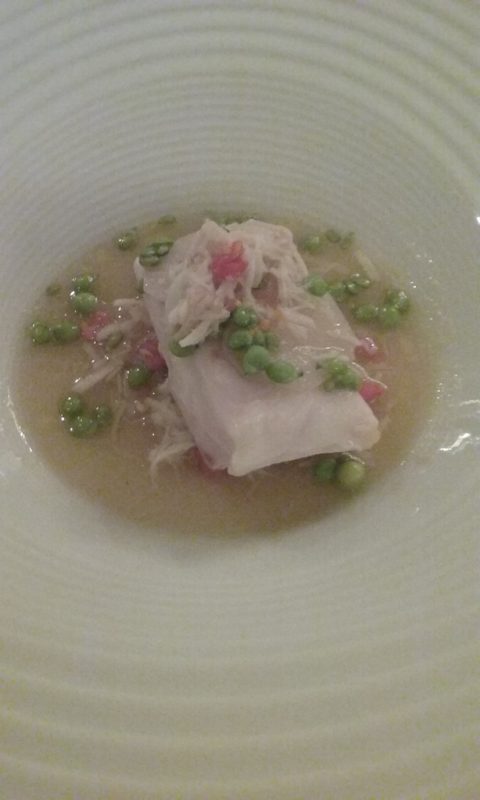
It Tasted as Delicate as It Looks
Just as Joél Robuchon has “Chocolate Temptation” as his signature dessert, it appears that Jose has his “Tangerine Menu” as his signature dessert. He freezes tangerine juice to form the shell of the tangerine and fills the inside with sherbet. Then he beds the tangerine down on a tangerine mousse, nestled comfortably in some tangerine leaves. Quite the creative presentation and quite the tangerine experience!
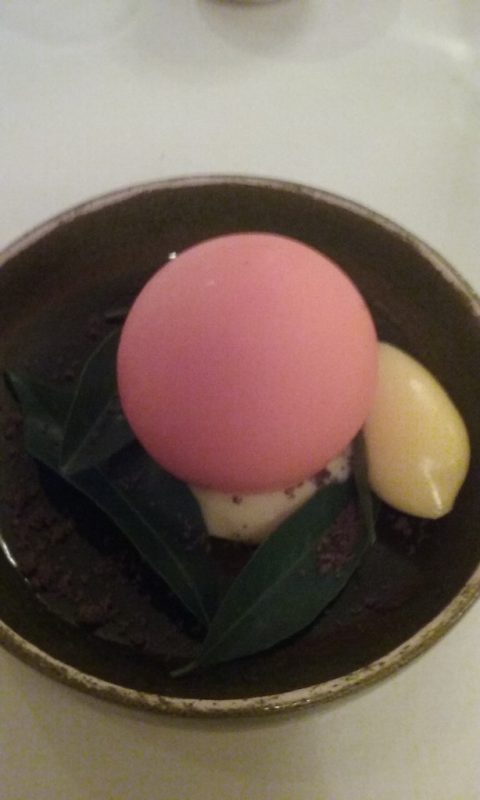
Tangerine Four Ways
All in all it was a delicious meal, delightfully presented, and full of explosive surprises. However, no matter how we tried, we could not find the link to the Age of Discovery.
Through the evening we had noticed every table but one had Americans at it. On some level it stands to reason, but still, it seemed odd. The waiter said on average it’s about half tourists, although not all Americans, and half Portuguese, even though that was not the case tonight.
In the time we ate dinner, the skies had opened up and it was raining. It was amusing, but on the way there, we pondered if the streets were challenging to walk on when the cobblestone got wet. Now we found out for ourselves – it was not any worse than dry, which can still have its challenges from being so uneven. We huffed it back toward to our hotel and in that time, it really started coming down. We didn’t mind, but with the wind and all, we opted for a shorter nighttime walk and a retreat with some hot tea back at home.
A Few More Alfama Shots
